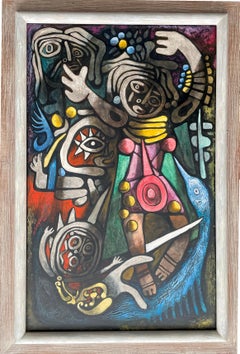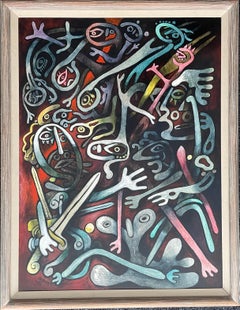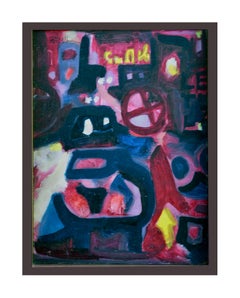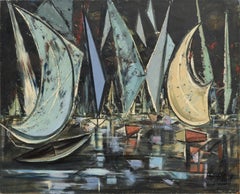Julio de Diego Abstract Paintings
Julio De Diego was one of the most colorful artists to work in Chicago. Born in Madrid in 1900, he left home at the age of 15 to apprentice as a scene painter for theatres. After service in the Spanish army, including six months fighting in North Africa, Diego traveled to Paris and Rome to study art. He also appeared as an extra in Diaghilev’s Ballet Russes. He emigrated to the United States in 1924. He lived in New York for two years, then went to Chicago, where he remained until 1942. At first, he earned a living as a magazine illustrator, decorative painter and graphic designer. By the early 1930s, Diego began to show regularly at the Art Institute of Chicago, appearing at thirty-two annual exhibitions of Chicago Artists, American artists and watercolorists, between 1931–47. He was employed by the easel division of the Illinois Art Project during the mid-1930s. He traveled to Mexico for the first time in 1939, becoming close friends with Carlos Mérida. Diego was deeply affected by the Spanish Civil War, and many of his works reflect the conflict that presaged the Second World War. Meditation over Inexplicable Logic seems to be a kind of preparation for his self-portrait in the Art Institute’s collection, titled The Perplexity of What To Do (1940). Both feature isolated, brooding figures lost in their inability to respond to events. He left Chicago in 1942 but continued to exhibit his work at major institutions. In 1946, Life magazine’s article described him spending time “cooking aromatic Spanish dishes and reading works of Spanish mystical philosophers and poets. He smokes cigarettes incessantly and dresses flamboyantly, affecting cerise mufflers and jangling bracelets.” Diego gained more notoriety in 1948 when he married the great burlesque artist, Gypsy Rose Lee. After their separation and divorce in the mid-1950s, he lived for a time in New York at the Chelsea Hotel, a haunt of artists, musicians and poets. Diego settled in Sarasota, Florida in 1967, near former friends from Chicago, where he died in 1979. Daniel Schulman References “Julio De Diego: He Paints Weird War and Peace.” Life Magazine, March 11, 1946. De Diego, Julio. Pamphlet File P-07866. Ryerson Library, Art Institute of Chicago.
1940s Modern Julio de Diego Abstract Paintings
Masonite, Oil, Tempera
1940s American Modern Julio de Diego Abstract Paintings
Masonite, Oil, Tempera
1940s American Modern Julio de Diego Abstract Paintings
Masonite, Oil, Tempera
1940s American Modern Julio de Diego Abstract Paintings
Masonite, Oil, Tempera
1940s Abstract Julio de Diego Abstract Paintings
Masonite, Oil
1960s Abstract Expressionist Julio de Diego Abstract Paintings
Masonite, Oil
1960s Abstract Geometric Julio de Diego Abstract Paintings
Masonite, Oil
1950s American Modern Julio de Diego Abstract Paintings
Oil, Board
1990s Abstract Expressionist Julio de Diego Abstract Paintings
Masonite, Oil
1960s Abstract Expressionist Julio de Diego Abstract Paintings
Masonite, Oil
Mid-20th Century Abstract Julio de Diego Abstract Paintings
Masonite, Oil, Paper
1940s American Modern Julio de Diego Abstract Paintings
Wax, Gouache, Archival Paper
1970s Abstract Expressionist Julio de Diego Abstract Paintings
Acrylic, Masonite
Audrey E. Gabrielson1970s Feminist San Francisco Abstract Expressionist Figurative (Two Sided), 1976
20th Century American Modern Julio de Diego Abstract Paintings
Oil
1960s Abstract Expressionist Julio de Diego Abstract Paintings
Masonite, Oil
1960s American Modern Julio de Diego Abstract Paintings
Oil, Linen
Early 2000s Modern Julio de Diego Abstract Paintings
Masonite, Acrylic
1940s Abstract Julio de Diego Abstract Paintings
Masonite, Oil






